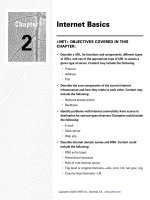Tài liệu Internet Learning Solutions Group Product Information Checklist (PIC) ppt
Bạn đang xem bản rút gọn của tài liệu. Xem và tải ngay bản đầy đủ của tài liệu tại đây (31.32 KB, 5 trang )
PIC –01/25/01 5:10 PM 1 of 5
I
I
n
n
t
t
e
e
r
r
n
n
e
e
t
t
L
L
e
e
a
a
r
r
n
n
i
i
n
n
g
g
S
S
o
o
l
l
u
u
t
t
i
i
o
o
n
n
s
s
G
G
r
r
o
o
u
u
p
p
P
P
r
r
o
o
d
d
u
u
c
c
t
t
I
I
n
n
f
f
o
o
r
r
m
m
a
a
t
t
i
i
o
o
n
n
C
C
h
h
e
e
c
c
k
k
l
l
i
i
s
s
t
t
(
(
P
P
I
I
C
C
)
)
P
P
r
r
o
o
d
d
u
u
c
c
t
t
I
I
n
n
f
f
o
o
r
r
m
m
a
a
t
t
i
i
o
o
n
n
(
(
E
E
P
P
D
D
-
-
P
P
M
M
)
)
Name of course or offering: Managing Cisco Network Security
Course acronym (must be unique, up to 5 letters, no #s): MCNS
Version: 2.1
FCS Date (PLM CM)
LOB: Enterprise
Offering type: course If other, please specify: Course
Delivery method: ILT x Cisco TV V-Labs VOD WBT Virtual classroom
Self study type: CD Book Tape Video
Duration if WBT in hours: 32.5
Duration if ILT in days 5 and hours: 40
Does course replace existing one? Yes x No (PLM-CM)
If yes, provide course name and/or acronym: MCNS 2.0
EOL date(PLM-CM)
A
A
s
s
s
s
e
e
s
s
s
s
m
m
e
e
n
n
t
t
I
I
n
n
f
f
o
o
r
r
m
m
a
a
t
t
i
i
o
o
n
n
(EPD – PM,
i
i
f
f
a
a
p
p
p
p
l
l
i
i
c
c
a
a
b
b
l
l
e
e
)
)
Sylvan test number:
COLT test number:
Is this product a part of these Career Certifications?
CCNA CCNP CCDA CCDP CCAP CCIE
T
T
r
r
a
a
i
i
n
n
t
t
h
h
e
e
T
T
r
r
a
a
i
i
n
n
e
e
r
r
(
(
I
I
R
R
P
P
)
)
Train the Trainer Required? Yes No x
If yes, TTT date:
TTT registration information:
Instructor prerequisites (including certifications and background knowledge):
To teach this course, instructors must attend the following training or complete the following requirements:
If you have already taught MCNS 2.0 and want to teach MCNS 2.1, you must:
§ Be a CCSI in good standing
§ Become familiar with the labs and exercises
If you have not taught MCNS before, to teach MCSN 2.1 you must:
§ Be a CCSI in good standing
§ Attend the MCNS 2.1 course
§ Become familiar with the exercises and labs in the course
Pass the MCNS 2.1 Sylvan test. Training Partners will be advised when the Sylvan test is scheduled for
release.
PIC –01/25/01 5:10 PM 2 of 5
T
T
a
a
r
r
g
g
e
e
t
t
A
A
u
u
d
d
i
i
e
e
n
n
c
c
e
e
(
(
E
E
P
P
D
D
-
-
P
P
M
M
)
)
Please describe who should attend this course
The target audience for this course is:
• Network administrators and technicians who are responsible for implementing and troubleshooting
complex routed network environments.
• CCNP and CCDP candidates
• CCIE Routing and Switching candidates
Upon completions of this training course, you will be able to select and implement the appropriate Cisco
IOS™ services required to build a scaleable, routed network.
Other If other, please describe the audience:
S
S
t
t
u
u
d
d
e
e
n
n
t
t
P
P
r
r
e
e
r
r
e
e
q
q
u
u
i
i
s
s
i
i
t
t
e
e
s
s
(
(
E
E
P
P
D
D
-
-
P
P
M
M
)
)
(Note: This field has a limit of 2000 characters.)
The MCNS course focuses on techniques and technology for enabling security in enterprise networks. To
fully benefit from MCNS, you must posses the following prerequisite skills and knowledge:
• Internetworking fundamentals
• Basic routing protocol concepts
• Basis router configuration
• Standard and extended access list configuration
• Cisco Dialup networking fundamentals recommended
Note: Students enrolled in the Cisco Career Certification program should be a Cisco Certified Network
Associate before taking this course. Those persons not seeking certification still must complete the
prerequisites listed before enrolling in this course.
C
C
o
o
u
u
r
r
s
s
e
e
O
O
b
b
j
j
e
e
c
c
t
t
i
i
v
v
e
e
s
s
(
(
E
E
P
P
D
D
-
-
P
P
M
M
)
)
Please list the 6-8 course objective (Bulleted)
After completing this course, the student should be able to:
• Identify network security threats
• Evaluate a network security policy
• Secure remote dialin access using CiscoSecure ACS (for MS Windows NT) and Cisco IOS AAA
software features
• Protect Internet access by configuring a Cisco perimeter router and a PIX Firewall
• Use IPSec features in Cisco IOS software to create a secure VPN
C
C
o
o
u
u
r
r
s
s
e
e
D
D
e
e
s
s
c
c
r
r
i
i
p
p
t
t
i
i
o
o
n
n
(
(
E
E
P
P
D
D
-
-
P
P
M
M
)
)
(Note: This field has a limit of 2000 characters.)
Managing Cisco Network Security is a course that focuses on how to build and manage enterprise-class
security. This course also introduces the emerging security technology and describes how it enhances
performance and scalability in campus networks. On completion of this training course, you will be able to
connect, configure, and troubleshoot the various security-related elements of an enterprise.
PIC –01/25/01 5:10 PM 3 of 5
C
C
o
o
u
u
r
r
s
s
e
e
O
O
u
u
t
t
l
l
i
i
n
n
e
e
(
(
E
E
P
P
D
D
-
-
P
P
M
M
)
)
Evaluating Network Security Threats
Configuring the NAS for AAA security
Configuring CiscoSecure ACS and TACACS+
Configuring PIX Firewall Basics
Configuring Access through the PIX Firewall
Configuring Multiple Interfaces and AAA on the PIX Firewall
Configuring Advanced PIX Firewall Features
Configuring a Cisco Perimeter Router
Configuring the CiscoSecure Integrated Software
Understanding Cisco IOS IPSEC Support
Configuring Cisco IOS IPSec
Scaling Cisco IOS IPSec Networks
Configuring the CiscoSecure VPN Client
PIC –01/25/01 5:10 PM 4 of 5
E
E
q
q
u
u
i
i
p
p
m
m
e
e
n
n
t
t
R
R
e
e
q
q
u
u
i
i
r
r
e
e
m
m
e
e
n
n
t
t
s
s
Recommended Equipment Minimum Equipment
Configuration
Interface
Classroom hardware:
(needed for any number of pods)
1 Cisco 2522 router 1 Frame Relay router
1 Computer – Windows NT 1 Computer – Windows NT ethernet NIC
1 Cisco serial cable (Cisco DTE one
end, Cisco DCE other end)
1 Cisco serial cable (Cisco DTE one
end, Cisco DCE other end)
1 Ethernet cross-over cable (RJ45
both ends)
1 Ethernet cross-over cable (RJ45
both ends)
2 Ethernet straight-through cables
(RJ45 both ends)
2 Ethernet straight-through cables
(RJ45 both ends)
1 terminal console connectors 1 terminal console connectors
1 black Cisco console cable 1 black Cisco console cable
Per pod hardware:
(2 students per pod)
1 Computer – Windows NT 1 Computer – Windows NT ethernet NIC and modem
1 Web (and FTP) server 1 Web (and FTP) server ethernet NIC
1 Cisco 1720 router 1 router 2 ethernet interfaces
1 Cisco 3640 router 1 router An ethernet interface in
slot 0 and a serial
interface (either 4 or 8
port) in slot 3)
1 Cisco PIX 520 PIX 510, 515, etc. can be used It must have 3 ethernet
interfaces installed
1 USR 56 Sportster External modem Other external modems would work
1 Ethernet hub 1 Ethernet hub 3 ports minimum
1 Teltone telephone simulator Telephone lines or other simulators
would work.
Each pod needs two
phone lines.
1 Cisco serial cable (Cisco DTE one
end, Cisco DCE other end)
1 Cisco serial cable (Cisco DTE one
end, Cisco DCE other end)
1 Cisco serial cable (Cisco DTE one
end, DB25 male serial other end)
1 Cisco serial cable (Cisco DTE one
end, DB25 male serial other end)
2 RJ11 long phone cables Something to connect the computers
modem to the phone simulator and to
connect the phone simulator to the
external modem
1 Ethernet cross-over cable (RJ45
both ends)
1 Ethernet cross-over cable (RJ45
both ends)
4 Ethernet straight-through cables
(RJ45 both ends) one must be long
and the other three can be short
4 Ethernet straight-through cables
(RJ45 both ends) one must be long
and the other three can be short
2 terminal console connectors
one for the computer and one for the
routers and PIX
2 terminal console connectors
PIC –01/25/01 5:10 PM 5 of 5
1 black Cisco console cable 1 black Cisco console cable









